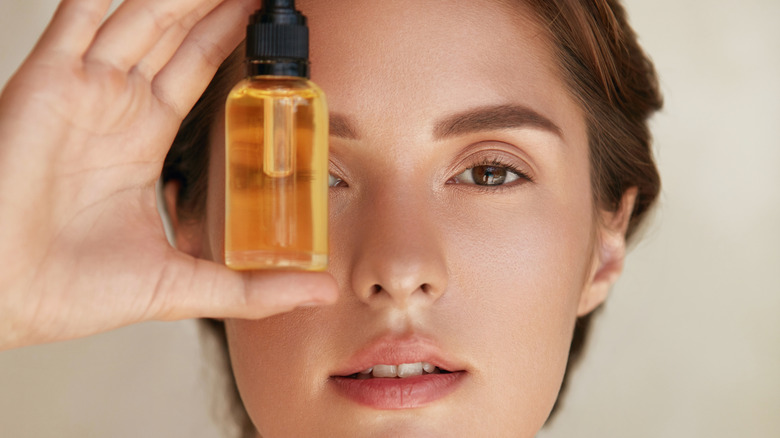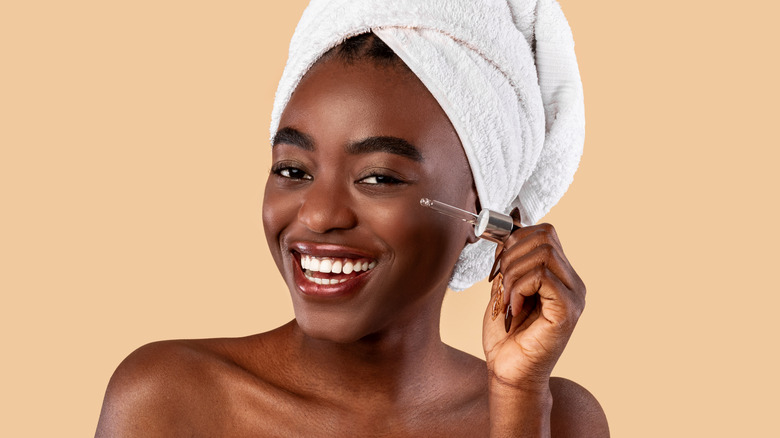Is It Safe To Layer Hyaluronic Acid And Retinol?
Taking skincare seriously is perhaps the single most important component of your beauty routine. After all, healthy skin provides a better foundation for your makeup, and it also allows you to go bare-faced whenever and wherever you want. While there's an abundance of skincare products on the market, some have garnered a cult-like following because they work wonders for your complexion.
According to Forefront Dermatology, skin renews itself every 28 days, leaving behind a fresh face. There is, of course, nothing wrong with allowing nature to take its course, but some skincare products enhance your body's regenerative properties by speeding up this process on the cellular level and making your skin glow like new.
Once you find a holy grail skincare product, knowing what other products to pair it with to achieve your skincare goals is crucial, especially since not all ingredients play nicely with others. On the other hand, some are a match made in heaven.
Take, for example, retinol and hyaluronic acid, two skincare powerhouses. Is it safe to layer these products together as part of your skincare routine?
Hyaluronic acid and retinol are a perfect pair
It's no secret that some skin care products are just not worth the money. In an interview with Byrdie, Marina Peredo, a board-certified dermatologist, shared what she believes are essential products in achieving the healthy, youthful glow we all crave. Not surprisingly, two ingredients that top her list are hyaluronic acid and retinol.
Per The Chub Scout, hyaluronic acid — which is naturally found in the body — works by retaining water within the skin, leaving your face looking plump and glowy. Although it's an acid, it doesn't have the harsh, abrasive qualities that you might expect from an acid. It's nourishing and hydrating — like giving your face a drink of water.
Retinol, on the other hand, works at the cellular level to regenerate your skin's outermost layer more quickly by increasing the production of collagen and elastin, according to Healthline. For those new to retinol, it can be a bit irritating and drying at first since it's encouraging the skin to turn over more quickly, sometimes resulting in peeling and redness. That's why some prefer to start a retinol regimen by only applying it a few times a week and building up from there, giving your skin time to adjust to the ingredient.
These two ingredients paired together create an environment for the regenerative processes to take place while keeping skin hydrated. When used together, these two ingredients have all the anti-aging bases covered.
But there are a few more things you should know about retinol before introducing it into your skincare regimen.
Retinol can be problematic
While hyaluronic acid and retinol go together like peanut butter and jelly, not all ingredients can coexist so harmoniously. According to InStyle, retinol can be difficult to combine with other ingredients that can be harsh on the skin, like alpha-hydroxy acids (AHAs) and beta-hydroxy acids (BHAs). Combining them could lead to serious adverse reactions, like irritation and redness. AHAs and BHAs are chemical exfoliators that are meant to help resurface the skin, making their use with a retinol redundant.
In an article for Skincare.com, dermatologist Elizabeth Houshmand also cautions against the use of benzoyl peroxide — a powerful acne fighter — and retinol together. "Benzoyl peroxide and retinoids should not be used together because they will deactivate each other and make the retinoid ineffective," she said.
Navigating the skincare world can be complicated and confusing at times, but listening to the experts and finding the correct combination of ingredients to treat your particular areas of concern can be a game changer.


